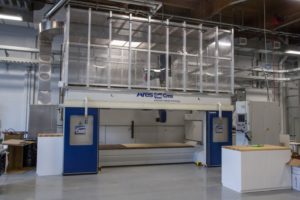Camosun is opening its new Babcock Canada Interaction Lab to students on October 24.
The lab is set to provide students with real-life problems that, once solved, will benefit local companies, mainly in the small-scale manufacturing and product-development sectors.
The college’s intent for the lab is for students to get hands-on work experience. Working in the lab will also give students pre-job knowledge of machinery such as 3D printers and water jet cutters.
Camosun vice president of education John Boraas says the lab will be the groundwork for the college’s next Interaction Lab, which will be at the Lansdowne campus.

“The primary reason that the first lab is out at Interurban is that the people who are in need of the Interaction Lab are the technology programs, so they’re going to be making use of that space,” says Boraas. “Our intent is to set up another one on Lansdowne once the new health building is finished and the nursing students move out.”
Boraas says that students can expect about six months of construction once work begins on the Interaction Lab at Lansdowne.
“It took about six months of construction at Interurban, so I don’t see why it would be any less [at Lansdowne],” says Boraas. “It might be a somewhat different space, though; the space might be much more of a student gathering space and, compared to the Interurban lab, we might see more of a focus on the creative technologies, such as computing horsepower and those kinds of things.”
Camosun Applied Research and Innovation director Tim Walzak says that the Interaction Lab is the result of years of discussions and thinking. He also says that the lab will benefit both students and local businesses.
“The lab is a result of about five years of talks, and it really started out of our whole applied research innovation initiative, which was focused around bringing advanced manufacturing and abilities both to our students and to local companies,” says Walzak. “The whole concept became much larger than that once we started to think about it and also get feedback from both students and potential employers that they really wanted students to be working on real-world problems. That evolved our idea to the space that it is today, and that includes 3D scanners, 3D printers, and everything you need to actually make something in such a way that anyone can come in and start to share ideas about what their problems are and how we can find solutions for them.”
The lab is housed in the old sheet metal bay; Walzak says that it has filled the space up nicely. While the lab isn’t open yet, it has already been used for some small projects; so far, therehave been no problems.
“We received some federal funding as well as some private-sector funding to do our renovations,” says Walzak. “Once the new trades building was completed, the sheet metal bay was vacant, and we did some renovations to make it into both the Camosun Innovates space —so my staff have offices here—and the lab itself, which is rather large. We haven’t run into any issues so far; the college, local companies, and the granting council for the federal government have all been really supportive. Honestly, we’re just anxious to finish the renovations and get up and running.”
